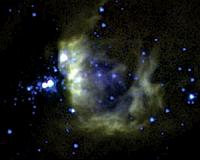 |
Pasadena CA (JPL) May 12, 2010 Astronomers are a bit like archeologists as they dig back through space and time searching for remnants of the early universe. In a recent deep excavation, courtesy of NASA's Spitzer Space Telescope, astronomers unearthed what may be the most distant, primitive cluster of galaxies ever found. In a twist, however, this apparent ancestor to today's "big cities" of grouped galaxies looks shockingly modern. Called CLG J02182-05102, the ancient cluster is dominated by old, red and massive galaxies, typical of present-day clusters. For example, it is similar to a young version of the Coma Cluster of today, which has had billions of more years to develop. "We are seeing something already aged and red like a younger version of the Coma Cluster from a distant, bygone era," said Casey Papovich, lead author of a new study and an assistant professor of physics and astronomy at Texas A and M University in College Station. Papovich added, "it is as though we dug an archeological site in Rome and found pieces of modern Rome in amongst the ruins." ClG J02182-05102 might have indeed been ahead of its time. Just as Rome was the world's biggest city more than 2,000 years ago with a population of about a million residents - a figure not again matched until the early 1800s in London - so too was this galactic grouping an advanced civilization for so early an era in the developing universe. Galaxy clusters are the largest gravitationally bound structures in the universe and are thought to have formed piecemeal over cosmic time. For now, ClG J02182-05102 is the only known galactic grouping so far away in the past, and studying it will help researchers understand the overall history of how galaxies congregate and evolve.
A Cosmic Archeological Expedition Because more light gathered means more information, the researchers looked at a cosmic region within this giant starscape that had also been studied by other instruments. These additional observations came from a survey combining light from Japan's Subaru telescope - housed atop Mauna Kea, Hawaii - and the European Space Agency's orbiting XMM-Newton telescope. The United Kingdom Infra-Red Telescope, also in Hawaii, provided infrared data along with another set of Spitzer observations called the Public Ultra Deep Sky survey. When all these data were compiled, Spitzer's infrared observations made dozens of distant galaxies jump out. "We would not have found this object without Spitzer because there is very little optical light coming from this group of galaxies," said Papovich. His team then obtained time on the Magellan telescope in Chile to study the faint light coming from ClG J02182-05102's least-dim galaxies. This light allowed the astronomers to archeologically date the candidate cluster to 9.6 billion years ago. With these observations, Papovich and his team confirmed that seven of ClG J02182-05102's galaxies have nearly the same distance, suggesting they are part of a grouping of about 60 galaxies. Whether or not this association of galaxies fully qualifies as a gravitationally bound cluster will rely on further observations. Furthermore, the definition of a "cluster" itself remains unsettled, somewhat like the blurry distinctions between a city and a town, made trickier still given the limited light that makes it to our telescopes from these relics.
The Rise and Fall of CLG J02182-05102 This puts them on par with the most mammoth galaxies in the nearby universe, which have grown fat through repeated mergers with other galaxies. These big galaxies are so uncharacteristic of those in the early universe that in some sense it is like finding modern skyscrapers in ancient Rome. The Papovich et al paper was accepted for publication in the Astrophysical Journal on April 21, 2010. A subsequent study by Masayuki Tanaka of the Institute for the Physics and Mathematics of the Universe in Japan confirmed the discovery, and the work was the subject of a news release on May 10, 2010.
Share This Article With Planet Earth
Related Links Spitzer Space Telescope Stellar Chemistry, The Universe And All Within It
 Astronomers Plan Second Look At Mega Star Birthing Grounds
Astronomers Plan Second Look At Mega Star Birthing GroundsGainesville FL (SPX) May 12, 2010 Astronomers this summer will take a close look at a rare cosmic cradle for the universe's largest stars, baby bruisers that grow up to have 50 times the sun's mass. The international team of astronomers headed by University of Florida scientist Peter Barnes used an Australian radio telescope to find the cloud of gas and dust 8,000 light years away in the Southern sky constellation Carina. ... read more |
|
| The content herein, unless otherwise known to be public domain, are Copyright 1995-2010 - SpaceDaily. AFP and UPI Wire Stories are copyright Agence France-Presse and United Press International. ESA Portal Reports are copyright European Space Agency. All NASA sourced material is public domain. Additional copyrights may apply in whole or part to other bona fide parties. Advertising does not imply endorsement,agreement or approval of any opinions, statements or information provided by SpaceDaily on any Web page published or hosted by SpaceDaily. Privacy Statement |